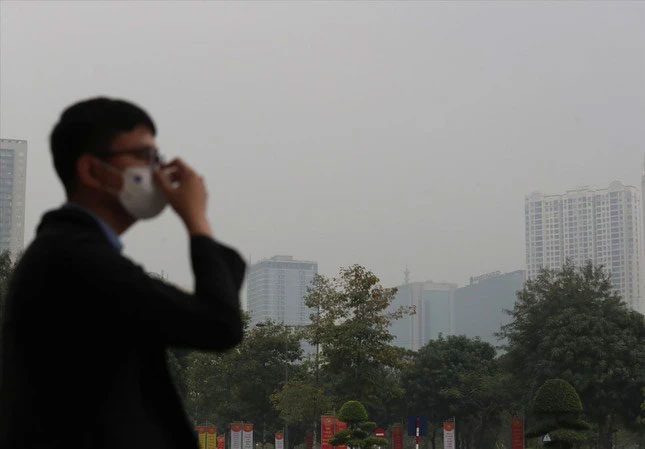Air Pollution in Hanoi and Northern Provinces Today (November 23) is More Severe than Two Days Ago. Most monitoring points are at purple levels, which are very harmful to human health, with many points reaching brown levels (dangerous for human health).
Air Quality Index (AQI) in Vietnam is categorized into six levels, where the red level (harmful to everyone’s health) indicates that all individuals may begin to experience health effects due to air pollution. The purple level (very harmful to human health) advises people to limit outdoor activities. The most dangerous level is the brown level, with recommendations for everyone to stay indoors as they may suffer serious health impacts.
This morning (November 23), the PAM Air air quality monitoring system recorded a higher number of pollution points at the purple level in Hanoi today.
Monitoring points at Chua Lang (Dong Da), the National Assembly Office Building (Nam Tu Liem), GCA Ecolife Kindergarten (Nam Tu Liem), Doi Can (Ba Dinh), and Trau Quy (Gia Lam) are all at levels very harmful to human health.
Notably, in Hanoi, two monitoring points at Sao Mai Center (Thanh Xuan) and the Vietnam Academy of Science and Technology (Cau Giay) reached hazardous levels with an AQI exceeding 300, which is dangerous for human health, advising everyone to stay indoors.
In the Red River Delta provinces, PAM Air monitoring points reported common air pollution levels at purple and brown levels.
The city of Nam Dinh and Hai Hau district in Nam Dinh province recorded air quality at brown levels this morning. Thai Thuy area in Thai Binh and Vinh Bao district in Hai Phong are also at brown levels.
Other monitoring points in Ha Nam, Hung Yen, and Bac Ninh are predominantly at purple levels.

Air pollution envelops Hanoi and many northern provinces this morning.
The air quality monitoring system of the Environmental Pollution Control Department also recorded common pollution at red and purple levels. Meanwhile, the air quality monitoring page of the U.S. Embassy reported a purple level.
The U.S. Embassy’s air quality monitoring page indicates that this wave of air pollution is expected to last for several more days in the northern provinces due to unfavorable weather conditions.
The most severe pollution will occur in the morning, while air quality will improve in the afternoon.
The Ministry of Health recommends that when air pollution reaches red levels, people should limit going outside, exercising, or working outdoors. When going out, it is essential to wear quality masks and ensure they fit properly (covering the nose and mouth securely).
Rinse your nose and gargle with saline solution morning and night, especially after being outdoors. Wash your eyes with saline solution in the evening before going to bed.
For smokers, it is advisable to quit or significantly reduce smoking. Non-smokers should avoid secondhand smoke. It is best to limit opening windows and doors during heavy pollution, especially for families near traffic routes or polluted areas.

Air pollution in the North is expected to last for several more days.
Regularly clean living spaces and ensure good ventilation in your environment. Limit or replace the use of traditional coal stoves, firewood, and straw with electric stoves, induction cookers, or gas stoves. Planting green trees in and around the house helps reduce dust and purify the air.
Individuals with respiratory diseases, chronic pulmonary disease, cardiovascular issues, malnutrition, and the elderly need to adhere strictly to the above preventive measures. Additionally, they should minimize outdoor activities, especially during periods of heavy pollution.
Air pollution in Hanoi and the northern provinces is attributed to sources from transportation, construction, industry, and residential activities such as burning waste and straw. The period from October to March each year is considered “the air pollution season” in Hanoi and the northern provinces. This time is characterized by frequent severe air pollution episodes due to weather conditions preventing the dispersal of pollutants. Experts advise that the public should regularly monitor air quality to take protective measures for their health and that of their families. |


















































